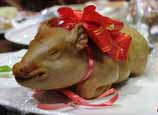
Related reading:
Top 10 Chinese art works sold at auctions for 2013
Aged-old dian cui art risks being lost forever
For glassmaker Wang Qin, Oriental luxury does not glitter and it bears no cliched "Chinese elements" such as lotus, bamboo and Buddhas.
"These elements or symbols of China have already become a cliché after thousands of repetitions," he says. "I wanted to dig out something indescribable that perfectly reflects the beauty of ancient Chinese culture."
"Implications of the Oriental spirit" is an expression often used by the Shanghai-based artist.
Wang's works are of stunning simplicity and drama. He says they have a Zen quality.
Unlike other artists who work in glistening, transparent glass, Wang prefers to use opaque black, gray and milky white, reminiscent of traditional Chinese ink-wash paintings.
A shallow white bowl on a pedestal is shaped with four rounded, petal-like sides. A dramatic vase of irregular, transparent glass is made with a floating inner design that appears to be black ink crosses or strokes reminiscent of Chinese characters. Sometimes "accidental" milky fragments float inside gray glass.
His brand is Qin (沁) and this year Wang has created around six objects and utensils from a traditional Chinese scholar's studio, including paintbrush pots, paperweights and pen rests.
"This first series is inspired by the ancient Chinese literati's passion toward rocks, such as Taihu rock from Taihu Lake in Jiangsu Province." The stone is famous for unusual shapes and it is often placed in gardens; smaller rocks may be placed on pedestals for contemplation.
"The shape and nuance of hues in the works are profound with a Zen touch," he says. "In my eyes, this is Chinese luxury. It involves continuously experimenting with shape and color, polishing and firing. All this is pure hand labor and I enjoy the whole process."
Wang was born in 1972 in Jingdezhen, Jiangxi Province, a famous "cradle" of Chinese ceramics. At first he followed in his predecessors' footsteps and majored in ceramics.
But when he visited an international glass art exhibition at Shanghai Art Museum in 2003, he fell in love with glass and changed direction.
"The work of top glass artists around the world totally changed my stereotyped concepts of glass," Wang says. "Glass used to seem cold and distant, unlike ceramics that were mild and warm."
Those works reflected a Western aesthetic, and Wang decided he wanted to make glass art reflecting the Oriental spirit.
He then studied in the glass art department of the Academy of Fine Arts at Shanghai University.
"The techniques in creating ceramics and glass works are quite similar since both must be fired," Wang says. "But the procedure for glasswork is more complicated and requires polishing."

















 Floodwater gushes from sluices of Gezhou Dam, China's Hubei
Floodwater gushes from sluices of Gezhou Dam, China's Hubei


![]()
